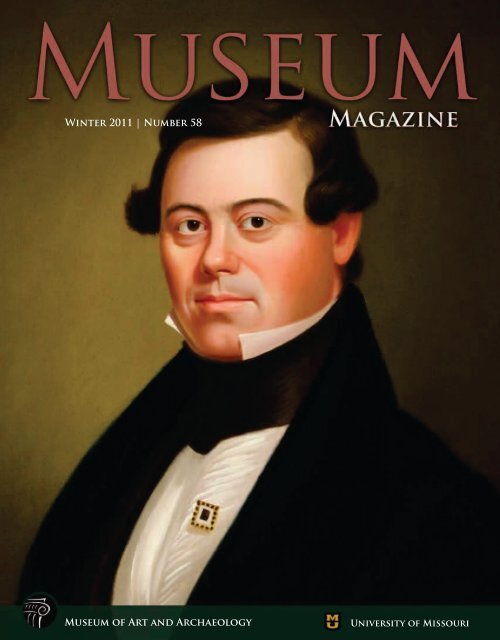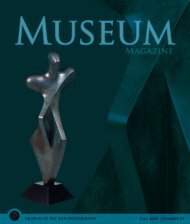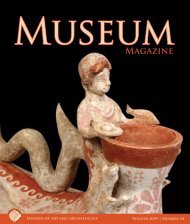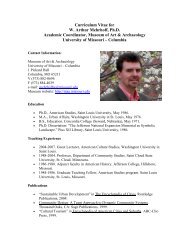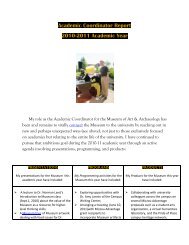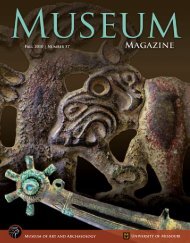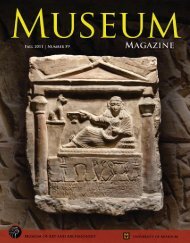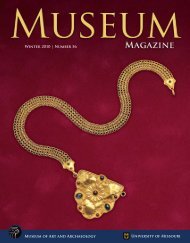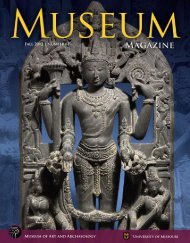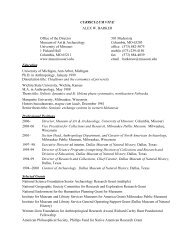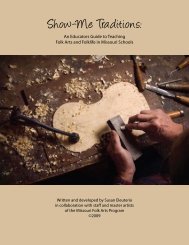Winter 2011 - Museum of Art and Archaeology - University of Missouri
Winter 2011 - Museum of Art and Archaeology - University of Missouri
Winter 2011 - Museum of Art and Archaeology - University of Missouri
- No tags were found...
You also want an ePaper? Increase the reach of your titles
YUMPU automatically turns print PDFs into web optimized ePapers that Google loves.
<strong>Winter</strong> <strong>2011</strong> | Number 58<strong>Museum</strong> <strong>of</strong> <strong>Art</strong> <strong>and</strong> <strong>Archaeology</strong><strong>University</strong> <strong>of</strong> <strong>Missouri</strong>
ContentsMission StatementThe <strong>Museum</strong> <strong>of</strong> <strong>Art</strong> <strong>and</strong> <strong>Archaeology</strong> advancesunderst<strong>and</strong>ing <strong>of</strong> our artistic <strong>and</strong> cultural heritagethrough research, collection <strong>and</strong> interpretation. Wehelp students, scholars <strong>and</strong> the broader communityto experience authentic <strong>and</strong> significant art <strong>and</strong>artifacts firsth<strong>and</strong>, <strong>and</strong> to place them in meaningfulcontexts. We further this mission by preserving,enhancing <strong>and</strong> providing access to the collectionsfor the benefit <strong>of</strong> present <strong>and</strong> future generations.© Copyright 2010 <strong>Museum</strong> <strong>of</strong> <strong>Art</strong> <strong>and</strong> <strong>Archaeology</strong>, <strong>University</strong> <strong>of</strong> <strong>Missouri</strong>-Columbia25678101213141617A Midwestern View: The <strong>Art</strong>ists <strong>of</strong> theSte. Genevieve <strong>Art</strong> ColonyLove, Life, Death <strong>and</strong> Mourning:Remembrance in Portraits byGeorge Caleb BinghamCIA: Counterfeits, Imitations <strong>and</strong>Alterations <strong>of</strong> Ancient CoinsSpecial ExhibitionsEvents Calendar<strong>Missouri</strong> Folk <strong>Art</strong>s ProgramRan In-Ting’s Watercolors: East <strong>and</strong>West Mix in Images <strong>of</strong> Rural TaiwanNew AcquisitionsFrom the Educator<strong>Museum</strong> AssociatesSpotlight: Bakongo Power Figure<strong>Museum</strong> Galleries:Tuesday through Friday: 9am to 4pmThursday Evenings until 8pmSaturday <strong>and</strong> Sunday: noon to 4pm<strong>Museum</strong> Store:Tuesday through Friday: 10am to 4pmThursday Evenings until 8pmSaturday <strong>and</strong> Sunday: noon to 4pmClosed:Mondays<strong>University</strong> <strong>of</strong> <strong>Missouri</strong> Holidays <strong>and</strong> Christmas Daythrough New Year’s DayAdmission is FREE <strong>and</strong> open to the publicThe <strong>Museum</strong> is ADA Accessible<strong>Museum</strong> AssociatesIn Support <strong>of</strong> the <strong>Museum</strong> <strong>of</strong> <strong>Art</strong> <strong>and</strong> <strong>Archaeology</strong>Officers:Robin LaBrunerie, PresidentGary Upton, TreasurerDirectors:Emilie AtkinsMarcela ChavezJuanamaria Cordones CookRobert DoroghaziJeannette FrenchKen GreeneEx Officio Directors:Alex Barker, <strong>Museum</strong> Director <strong>and</strong> Executive Vice-PresidentBruce Cox, Assistant Director, <strong>Museum</strong> OperationsMary Pixley, Curator, European <strong>and</strong> American <strong>Art</strong>Anne Stanton, Chair, Department <strong>of</strong> <strong>Art</strong> History <strong>and</strong> <strong>Archaeology</strong>Ingrid Headley, Docent RepresentativeHonorary Directors:Patricia Atwater, Libby Gill, Osmund Overby, Betty Proctor <strong>and</strong> Patricia Wallace<strong>Museum</strong> <strong>of</strong> <strong>Art</strong> <strong>and</strong> <strong>Archaeology</strong>Editorial Office: 1 Pickard Hall<strong>University</strong> <strong>of</strong> <strong>Missouri</strong>-Columbia, Columbia, MO 65211Phone: (573) 882-3591 Fax: (573) 884-4039Visit us online: http://maa.missouri.eduEditorial Staff: Bruce Cox, EditorKristie Lee, Graphic DesignerTerri Rohlfing, SecretaryPam HuffstutterMark KochElizabeth KraatzJennifer LarmieGail MetzVicki OttJennifer PerlowKathleen PitzerSusan ReynoldsAnnette SobelScott SouthwickGil StoneAnne TuckleyThe magazine is published biannually by the <strong>Museum</strong> <strong>of</strong> <strong>Art</strong> <strong>and</strong> <strong>Archaeology</strong>,<strong>University</strong> <strong>of</strong> <strong>Missouri</strong>-Columbia, <strong>and</strong> is paid for through membership fees,donations <strong>and</strong> gift contributions to <strong>Museum</strong> Associates.<strong>Museum</strong> galleries display art <strong>and</strong> artifacts from six continents <strong>and</strong> more than fivemillennia. Lectures, seminars, gallery talks <strong>and</strong> educational programs associatedwith permanent <strong>and</strong> temporary exhibitions provide a wide range <strong>of</strong> cultural <strong>and</strong>educational opportunities for all ages.The <strong>Museum</strong> <strong>of</strong> <strong>Art</strong> <strong>and</strong> <strong>Archaeology</strong> is located in Pickard Hall on historic FrancisQuadrangle, at the corner <strong>of</strong> <strong>University</strong> Avenue <strong>and</strong> S. Ninth Street, on the <strong>University</strong><strong>of</strong> <strong>Missouri</strong> campus in Columbia, Mo.MU does not discriminate on the basis <strong>of</strong> race, color, religion, sex, sexual orientation, nationalorigin, age, disability or status as a Vietnam Veteran. For more information, call Human ResourcesServices at: (573) 882-4256 or the U.S. Department <strong>of</strong> Education, Office <strong>of</strong> Civil Rights.<strong>University</strong> <strong>of</strong> <strong>Missouri</strong> is an equal opportunity/ADA institution.[Cover]IGeorge Caleb Bingham (American, 1811–1879)Portrait <strong>of</strong> Thomas Withers Nelson (detail), ca. 1844–1845Oil on canvas(2003.5)Gilbreath-McLorn <strong>Museum</strong> Fund
From the DirectorThis past semester I’ve been teaching a graduate seminar in museum studies.As their final project the students designed exhibitions, presenting them (<strong>and</strong>defending them) to the rest <strong>of</strong> the class. I placed no major constraints on topicsor design, except that they needed to be able to justify the choices they madein terms <strong>of</strong> the technical constraints on particular kinds <strong>of</strong> objects, the needs <strong>of</strong>audiences, <strong>and</strong> the didactical limitations <strong>of</strong> exhibition labels. I think—I hope—they learned a lot. I know I did.The students addressed a wide range <strong>of</strong> topics, from the ambiguity <strong>of</strong> gender <strong>and</strong> identity in the works <strong>of</strong> contemporaryartist Cindy Sherman to the effects <strong>of</strong> pesticide <strong>and</strong> prospects for controlling pests using natural means, <strong>and</strong> from cuisine inancient Rome to a powerful <strong>and</strong> disturbing treatment <strong>of</strong> racism <strong>and</strong> lynching. All <strong>of</strong> them had areas <strong>of</strong> special strength, <strong>and</strong>each <strong>of</strong> them had one or more “aha!” moments <strong>of</strong> resonance <strong>and</strong> wonder.Stephen Greenblatt—one <strong>of</strong> my favorite authors—argues that this is the proper role <strong>of</strong> museums; we are purveyors <strong>of</strong>resonance <strong>and</strong> wonder, <strong>and</strong> these are the currencies by which value in museums is measured. “Resonance,” he argues, is theability for an exhibition to engage us, to find a way to connect with us at an immediate <strong>and</strong> human level. It’s the commonground that makes an exhibition relevant to us as individuals or communities. “Wonder” is the magical ability <strong>of</strong> exhibitionsto transport us out <strong>of</strong> our time <strong>and</strong> place to appreciate new ways <strong>of</strong> seeing, to experience ancient worlds long faded to dust,or to imagine new worlds not yet born.Over the next year the <strong>Museum</strong> <strong>of</strong> <strong>Art</strong> <strong>and</strong> <strong>Archaeology</strong> will mount a series <strong>of</strong> exhibitions that <strong>of</strong>fer the chance to travel t<strong>of</strong>araway or long past worlds, to see the world through other eyes, <strong>and</strong> to return to our own with a fresh perspective—inother words, exhibitions <strong>of</strong> resonance <strong>and</strong> wonder. We begin with A Midwestern View: The <strong>Art</strong>ists <strong>of</strong> the Ste. Genevieve<strong>Art</strong> Colony, which examines an influential but now little-known art colony in southeastern <strong>Missouri</strong>. Next is Ran In-Ting’sWatercolors: East <strong>and</strong> West Mix in Images <strong>of</strong> Rural Taiwan, an exhibition <strong>of</strong> watercolors by one <strong>of</strong> the most acclaimedTaiwanese artists <strong>of</strong> the 20th century. And we follow that exhibition with an examination <strong>of</strong> commerce in the ancient world.The Mediterranean Melting Pot: Commerce <strong>and</strong> Cultural Exchange in Antiquity traces the far-flung trade connections thatmade the economics <strong>of</strong> the Greco-Roman world pr<strong>of</strong>oundly international in both scope <strong>and</strong> character.We’ll also be <strong>of</strong>fering a smaller numismatic exhibition curated by collections specialist Kenyon Reed. CIA: Counterfeits,Imitations <strong>and</strong> Alterations <strong>of</strong> Ancient Coins looks beyond more traditional presentations <strong>of</strong> ancient coins <strong>and</strong> examines theways they were faked, altered, <strong>and</strong> manipulated in antiquity. This exhibition <strong>and</strong> Benton Kidd’s Mediterranean Melting Pot inFall <strong>2011</strong> bring into sharper focus similarities between the ancient world <strong>and</strong> our own. And along the way we’ll also mount asmall exhibition celebrating the life <strong>of</strong> George Caleb Bingham, examining themes <strong>of</strong> sentiment <strong>and</strong> loss in his portraits.We have ourselves experienced losses that leave all <strong>of</strong> us saddened. Herb Brown, husb<strong>and</strong> <strong>of</strong> the late Betty Brown <strong>and</strong> afamiliar face at <strong>Museum</strong> functions, passed away earlier this year. And Jean McCartney, an active <strong>Museum</strong> docent <strong>and</strong> regularpatron <strong>of</strong> all <strong>of</strong> the arts institutions <strong>of</strong> the area, died suddenly in December. Both will be very deeply missed; both remind usto hold our friends <strong>and</strong> family—another source <strong>of</strong> resonance <strong>and</strong> wonder—all the more tightly.See you at the <strong>Museum</strong>!Alex W. BarkerDirector
A Midwestern ViewThe ArT isT s <strong>of</strong> T h esTe. Genevieve ArT ColonyJanuary 29 – May 15, <strong>2011</strong>From 1932 until 1941, several like-minded artists gathered every summer tocreate art in Ste. Genevieve, the oldest town in <strong>Missouri</strong>. The time the artistsspent at the Colony was <strong>of</strong>ten one <strong>of</strong> experimentation. While in many such coloniesartists frequently worked in a similar style, the artists at Ste. Genevieve showed theirindividualism <strong>and</strong> wide-ranging artistic knowledge as they worked in numerousmanners. This exhibition explores the diversity <strong>of</strong> these artists <strong>and</strong> the richness <strong>of</strong> theirart, as well as the important role <strong>of</strong> <strong>Missouri</strong> in Midwestern art.Located only 65 miles south <strong>of</strong> St. Louis on the west bank <strong>of</strong> the Mississippi River,Ste. Genevieve was a peaceful refuge, which still provided access to a major urbancenter with talented artists who could serve as faculty. In addition, the area provideda bountiful supply <strong>of</strong> local art students as well as audiences for group exhibitions.The numerous examples <strong>of</strong> picturesque French Colonial architecture <strong>and</strong> the town’sproximity to the river, farml<strong>and</strong>s, <strong>and</strong> lime industry promised a variegated l<strong>and</strong>scapewith differing qualities <strong>of</strong> light <strong>and</strong> air.2
Jessie Beard Rickly (1895–1975)Still life, Lilies <strong>and</strong> FruitCa. 1930WatercolorLent by the John <strong>and</strong> SusanHorseman CollectionE. Oscar Thalinger (1885–1965)The Old Rock House, orSte. Genevieve in <strong>Winter</strong>Ca. 1932Oil on canvasLent by the John <strong>and</strong> SusanHorseman Collection Left to right: Martyl Schweig (b. 1918) Erosion, ca. 1942, oil on masonite; MiriamMcKinnie (1906–1987), Women Gathering Greens, ca. 1937, oil on canvas; BernardE. Peters (1893–1949), untitled (l<strong>and</strong>scape), ca. 1930, oil on canvas; all lent by theJohn <strong>and</strong> Susan Horseman collection.This atmosphere would have appealed to Aimee Schweig <strong>and</strong>Jesse Rickly, the founders <strong>of</strong> the Ste. Genevieve Summer School<strong>of</strong> <strong>Art</strong>, who had learned the plein air (French for open air oroutside) method <strong>of</strong> painting under Charles Hawthorne at theProvincetown art colony in Massachusetts. With a programinspired by that <strong>of</strong> Provincetown, they hoped that their schoolwould increase the appreciation <strong>of</strong> art in the Middle West as wellas “perpetuate Midwestern life by the preservation <strong>of</strong> its scenes<strong>and</strong> types in paint.”While much <strong>of</strong> the art produced at Ste. Genevieve showedAmerican life portrayed in a naturalistic vein, to categorize thecolony as a center for only Regionalist <strong>and</strong> Social Realist art deniesthe artistic pluralism that thrived there. The artists at the colonywere <strong>of</strong>ten well traveled <strong>and</strong> aware <strong>of</strong> artistic trends on the EastCoast, in the American Southwest <strong>and</strong> Mexico, as well as much<strong>of</strong> Europe including Madrid, Paris, <strong>and</strong> Munich. They used theirknowledge to paint scenes <strong>of</strong> the Midwest in a variety <strong>of</strong> deeplypersonal styles.A view <strong>of</strong> the riverfront in St. Louis by Joe Jones shows himpainting in a temperate modernist vein. The hard edged <strong>and</strong>simplified forms with smooth surfaces <strong>and</strong> restrained modelingreflect his knowledge <strong>of</strong> the Polish artist Tamara de Lempicka,Georgia O’Keefe, <strong>and</strong> the pure geometric forms <strong>of</strong> precisionist art.Miriam McKinnie was also known for her moderate modernism,but her painting Women Gathering Greens reveals a remarkablesculptural quality as she transforms a Renaissance triangle constructioninto a powerful composition showing women hard atwork outside on their knees.3
Joseph Paul Vorst (1897–1947)Sharecroppers’ RevoltCa. 1940Oil on panelLent by the John <strong>and</strong> SusanHorseman CollectionJoseph Vorst used an expressive style, reflective <strong>of</strong> his studywith Thomas Hart Benton (Benton spent only one day teachingat the colony), to portray <strong>and</strong> call attention to poverty along theMississippi. His Sharecroppers’ Revolt painted in 1939 shows theplight <strong>of</strong> jobless tenant farmers. Evicted from their housing, theymust now live in a makeshift house made <strong>of</strong> quilts during thecold <strong>of</strong> winter. In The Old Rock House <strong>of</strong> 1932, Oscar Thalingershows unemployed workers huddling for protection near anab<strong>and</strong>oned residence at the river’s edge as they wait for daylabor on a barge. He exhibited at the <strong>Museum</strong> <strong>of</strong> Modern <strong>Art</strong>a year later. The richness <strong>of</strong> his coloring, which so effectivelyevokes the ambience <strong>of</strong> this scene, reflects his study withHermann Groeber in Munich.Several <strong>of</strong> the artists chosen for this exhibition were <strong>of</strong> majorimportance to the success <strong>of</strong> the art colony. Bernard Peterswas at the colony from the beginning, encouraged by FrankNuderscher, who also painted at Ste. Geneieve <strong>and</strong> served asDirector <strong>of</strong> the Ozark School <strong>of</strong> <strong>Art</strong>. A highly educated artist,Peters had studied in Engl<strong>and</strong>, France, at St. Louis <strong>University</strong>, <strong>and</strong>at Harvard <strong>University</strong>. His studies at Gloucester in Massachusetts,however, perhaps proved the most influential as he adopted thesimilar broken application <strong>of</strong> paint used by Frederick Mulhaupt(also from <strong>Missouri</strong>), who was a leading painter <strong>of</strong> this port city.Both Schweig <strong>and</strong> Rickly hoped that the colony <strong>and</strong> school<strong>of</strong> Ste. Genevieve would help focus the artistic ambitions <strong>of</strong> theparticipants <strong>and</strong> provide opportunities for collegial gatherings<strong>and</strong> interesting artistic discussions, as well as encourageinterest in the art <strong>and</strong> artists who participated. The art colonysucceeded in achieving these goals <strong>and</strong> its vitality can be seen inthe diversity <strong>of</strong> themes <strong>and</strong> responses to contemporary artistic<strong>and</strong> political issues. The works chosen for this exhibition, whilenot all produced at the colony, illustrate the creativity <strong>and</strong>experimental nature <strong>of</strong> many <strong>of</strong> the participating artists, whosaw beauty just as readily in the commonplace as in the artisticprocess itself. This exhibition illustrates the diversity <strong>of</strong> the artproduced in <strong>Missouri</strong>, the reality <strong>of</strong> which has been cloudedby the dominance <strong>of</strong> the style <strong>of</strong> Regionalism propounded byBenton <strong>and</strong> his circle.Even though the colony thrived <strong>and</strong> was viewed as a notableaddition to the artistic scene, the summer school disappearedafter 1938. Schweig <strong>and</strong> other artists from St. Louis continuedto visit Ste. Genevieve, but they did so in diminished numbers,<strong>and</strong> with the entry <strong>of</strong> the United States into World War II thecolony disintegrated. Fortunately, the story does not end there.Several <strong>of</strong> the artists associated with Ste. Genevieve continuedto have very productive careers, as they won prizes in paintingcompetitions, were selected for important exhibitions, <strong>and</strong>sometimes even had solo exhibitions in important cities. Despitethe continued prominence <strong>of</strong> the artists <strong>of</strong> the Ste. Genevieve <strong>Art</strong>Colony, they are not widely known today.4
Love, Life, Death <strong>and</strong> MourningRemembrance in Portraits by George Caleb BinghamFebruary 1 – April 17, <strong>2011</strong>Mary PixleyAssociate Curator <strong>of</strong>European <strong>and</strong> American <strong>Art</strong>The portraits selected forthis exhibition commemoratefamily, love, <strong>and</strong>life. They were created onvarious occasions to celebratea conjugal union or to mournthe passing away <strong>of</strong> a beloved.While traditional statements <strong>of</strong>position, power, <strong>and</strong> the socialinstitution <strong>of</strong> marriage, they alsoreveal the sentimentalism <strong>of</strong> anage in which death <strong>of</strong> familymembers—especially wives <strong>and</strong>children—was a familiar part <strong>of</strong>the social l<strong>and</strong>scape.Bingham combined a uniquemixture <strong>of</strong> accuracy <strong>and</strong> idealism in his portraits, which madehim a very popular portraitist throughout his career. He typicallyarranged his subject in a three-quarter pose with the persongazing directly at the viewer. Looking back at the viewer,Bingham’s sitters establish a personal <strong>and</strong> vivid link with us.Whether painted early or late in his career, Bingham’s portraitsshow a frank <strong>and</strong> unpretentious likeness that defined theAmerican character.The representations <strong>of</strong> single individuals shown in this exhibitrelate in differing ways to associated portraits <strong>of</strong> family members,both living <strong>and</strong> deceased. In pendant or paired portraits, thetorsos <strong>of</strong> the husb<strong>and</strong> <strong>and</strong> wife typically turn toward each otherPhotos: above, left to right, Mr. <strong>and</strong> Mrs. Henry SheffieGeyer (details), both ca. 1839, oil on canvas, lent bythe <strong>University</strong> <strong>of</strong> <strong>Missouri</strong> School <strong>of</strong> Law; Mrs. <strong>and</strong> Mr.Robert Beverly Price (details), both ca. 1862, oil oncanvas, lent by Albert M. <strong>and</strong> Margaret J. Price; center:Mrs. George Caleb Bingham <strong>and</strong> son Newton, 1842,oil on canvas, lent by Dr. Robert M. Doroghazi.as they represent the core <strong>of</strong> the family.While the 1839 portraits <strong>of</strong> Mr. <strong>and</strong>Mrs. Henry Sheffie Geyer (Joanna EastonQuarles) clearly mirror each other, those<strong>of</strong> Mr. <strong>and</strong> Mrs. Robert Beverly Price(Emma Prewitt) do not. Emma’s face isnot turned toward her husb<strong>and</strong>’s to thesame degree. With a subtle change inangle, Bingham indicated a disharmonybetween the two family members, whichin this case signaled the fact that Emmahad passed away three years prior to thepainting <strong>of</strong> these two portraits.A posthumous or mourning picture <strong>of</strong>a deceased family member was fairly common in the nineteenthcentury. In an interesting twist, the portrait <strong>of</strong> Thomas WithersNelson (pictured on the cover) shows the sitter wearing apiece <strong>of</strong> mourning jewelry featuring a large piece <strong>of</strong> jet. Whilehusb<strong>and</strong>s were not expected to wear mourning clothes as wiveswere, Thomas chose to have himself portrayed respectfullymourning the loss <strong>of</strong> a loved one. Bingham’s double portrait <strong>of</strong>his first wife Sarah Elizabeth <strong>and</strong> their son Isaac Newton firstserved as a lasting memorial <strong>of</strong> his recently deceased son, <strong>and</strong>six years later as a remembrance <strong>of</strong> his deceased wife. Capturing<strong>and</strong> preserving glimpses <strong>of</strong> family life <strong>and</strong> history, these portraitsserved as mementos in life <strong>and</strong> in death.5
CIA: Counterfeits, Imitations <strong>and</strong>Alterations <strong>of</strong> Ancient CoinsKenyon ReedCollections SpecialistEvery object in the museum tells astory, <strong>and</strong> this is especially true <strong>of</strong>coins. Most <strong>of</strong> the coins on permanentdisplay in the <strong>Museum</strong> tell a similar story,one that is short, sweet, <strong>and</strong> relativelysimple: they were struck at a mint, passedthrough a relatively small number <strong>of</strong> h<strong>and</strong>s,<strong>and</strong> then were lost or hidden away untilthey came to be on display in the <strong>Museum</strong>.Their stories are <strong>of</strong>ten <strong>of</strong> luxury <strong>and</strong> privilege,beauty <strong>and</strong> grace, refinement <strong>and</strong> class. But thecoins in this exhibition tell a different story. Their storiesare <strong>of</strong>ten longer, more convoluted, <strong>and</strong> complex, <strong>and</strong> are <strong>of</strong>tenfull <strong>of</strong> trickery <strong>and</strong> deceit, envy <strong>and</strong> imitation, violence <strong>and</strong> pain.The exhibition CIA: Counterfeits, Imitations <strong>and</strong> Alterations<strong>of</strong> Ancient Coins examines these coins in greater depth in anattempt to better tell their stories.Counterfeit coins tell the story <strong>of</strong> trickery, deceit, <strong>and</strong> greed.Counterfeits have been around as long as coins, <strong>and</strong> counterfeitbullion was one <strong>of</strong> the reasons coinage was invented. Ancientcounterfeits were designed to cheat the ancient consumer.Fouree coins, with a base metal core encased in either silveror gold, could circulate for years until their true worth wasdiscovered, while mold cast coins were mixed into bagscontaining <strong>of</strong>ficial currency, <strong>and</strong> probably went unnoticed by thegeneral population (Fig. 2). With the renewed interest in antiquitythat occurred during the Renaissance came a renewed interestin counterfeiting ancient coins, this time to cheat collectors, anactivity that, unfortunately, continues to this day.Imitations tell the stories <strong>of</strong> desperation, impersonation,<strong>and</strong> hope. Coins were imitated for a number <strong>of</strong> reasons. Somecoins were imitated because <strong>of</strong> their popularity <strong>and</strong> respectin international trade, a respect the issuers hoped to gainby copying these revered types. Others were imitated out <strong>of</strong>desperation, in order to provide coins in regions where theywere lacking. Some imitations tell the story <strong>of</strong> cultural influence,others the story <strong>of</strong> cultural or political changes, <strong>and</strong> still others<strong>of</strong> a yearning for the good old days. Imitations <strong>of</strong> ancient coinsFebruary 19 – July 31, <strong>2011</strong>made during the Renaissance speak both<strong>of</strong> helping collectors fill gaps in theircollections <strong>and</strong> <strong>of</strong> the maker’s ideasabout coins that should have existed inantiquity, but didn’t.Alterations tell the story <strong>of</strong> violence<strong>and</strong> pain inflicted by a wide variety <strong>of</strong>physical changes made to coins afterthey left the mint. Some alterations werepractical, such as test cuts to determine thepurity <strong>of</strong> the metal (Fig. 1); halving a coin toprovide much needed small change; countermarking torevalue or confirm the coin’s legitimacy; <strong>and</strong> overstriking, whichwas used to recycle worn coins, to revalue earlier issues, <strong>and</strong>to reinforce imperial authority (Fig. 4). Not all alterations wereutilitarian in nature; some were aesthetic. Large bronze coinswere sometimes hammered around the edge to create protocontorniates,which were then used as decoration on armor orcontainers, or as pieces for board games. Coins <strong>of</strong> all metals wereturned into pieces <strong>of</strong> jewelry. Bronze <strong>and</strong> silver coins were <strong>of</strong>tenjust pierced through so they could be suspended from a chain,but gold coins <strong>and</strong> medallions were usually provided with at leastan added loop, <strong>and</strong> were sometimes set as the centerpiece forextremely elaborate creations (Fig. 3).All <strong>of</strong> the stories told by the coins in this exhibition are rarelytold in regular displays. Some <strong>of</strong> the stories overlap, some mergetogether, but all help to bring to life the vivid <strong>and</strong> intriguing life<strong>of</strong> ancient coins.Fig. 1. Silver Stater <strong>of</strong> Datames, Greek, minted at Tarsus, ca. 373–368 BCE (69.234),<strong>Museum</strong> purchase <strong>and</strong> partial gift <strong>of</strong> Mrs. Mary Frances Osborne Davis <strong>and</strong> Mrs. SusanAnn Davis Aulgur in memory <strong>of</strong> John H. TownsendFig. 2. Terracotta Mold for Casting a Counterfeit Bronze Nummus <strong>of</strong> Maximinus II,Roman, Near East, ca. 317–320 CE (70.340), <strong>Museum</strong> purchaseFig. 3. Gold Medallion with Imitation Solidus, Byzantine, Palestine, Near Hebron, 5th–6thCentury CE (68.175 C), Chorn Memorial FundFig. 4. Bronze Follis <strong>of</strong> Heraclius, Byzantine, minted at Syracuse, 631 CE (69.880),<strong>Museum</strong> purchase <strong>and</strong> partial gift <strong>of</strong> Mrs. Mary Frances Osborne Davis <strong>and</strong> Mrs. SusanAnn Davis Aulgur in memory <strong>of</strong> John H. TownsendFig. 2 Fig. 3 Fig. 46
Special ExhibitionsAdmission is FREE <strong>and</strong> open to the public<strong>Museum</strong> is ADA Accessible<strong>Museum</strong> GalleriesTuesday through Friday: 9am to 4pmThursday Evenings until 8pmSaturday <strong>and</strong> Sunday: noon to 4pmClosed Mondays <strong>and</strong> <strong>University</strong> Holidays<strong>Museum</strong> StoreTuesday through Friday: 10am to 4pmThursday Evenings until 8pmSaturday <strong>and</strong> Sunday: noon to 4pmThrough–February 6, <strong>2011</strong>Equine <strong>Art</strong>Taking the theme <strong>of</strong> the horse, this focus exhibition reveals a passion for the horse that can be foundaround the world throughout time. While revealing a remarkable diversity <strong>of</strong> artistic approaches, theEquine <strong>Art</strong> exhibition also illustrates the different roles horses have played as they helped to shapehuman history.Through–May 15, <strong>2011</strong>A Midwestern View: The <strong>Art</strong>ists <strong>of</strong> the Ste. Genevieve <strong>Art</strong> ColonyDuring the 1930s <strong>and</strong> early 1940s, Ste. Genevieve (the oldest town in <strong>Missouri</strong>, located sixty miles south<strong>of</strong> St. Louis) was host to an important art colony. Founded by Aimee Schweig, Bernard Peters, <strong>and</strong>Jesse Rickly, these artists were joined by other Regionalist painters including Thomas Hart Benton, JoeJones, <strong>and</strong> Joseph Vorst. These painters hoped to develop an independent view <strong>of</strong> the world as theyresponded to contemporary political <strong>and</strong> artistic issues in various manners. This exhibition will explorethe diversity <strong>of</strong> these artists as well as the important role <strong>of</strong> <strong>Missouri</strong> in Midwestern art.February 1–April 17, <strong>2011</strong>Love, Life, Death <strong>and</strong> Mourning: Remembrance in Portraits by GeorgeCaleb BinghamTo commemorate the work <strong>of</strong> nineteenth-century <strong>Missouri</strong> artist George Caleb Bingham, this exhibitionfocuses on Bingham’s portraits <strong>and</strong> his unique ability to mix accuracy <strong>and</strong> idealism in the painting <strong>of</strong>his subjects. Subjects were painted to commemorate love, life, death <strong>and</strong> mourning as the cycle <strong>of</strong> lifewas captured through Bingham’s oil paint <strong>and</strong> brush strokes. Whether painted early or late in his career,Bingham’s portraits show a frank <strong>and</strong> unpretentious likeness that defined the American character.February 19–July 31, 201CIA: Counterfeits, Imitations <strong>and</strong> Alterations <strong>of</strong> Ancient CoinsThis exhibition focuses on aspects <strong>of</strong> ancient coinage rarely considered in a museum setting. The sectionon counterfeits investigates coins designed to cheat, either the ancient consumer or the modern collector.Imitations probe the complex relationship <strong>of</strong> coins to the past <strong>and</strong> their various meanings. Lastly,the segment on altered coins examines the various physical changes made to coins after they left themint <strong>and</strong> the reasons for these changes.May 28–August 14, <strong>2011</strong>Ran In-Ting’s Watercolors: East <strong>and</strong> West Mix in Images <strong>of</strong> Rural TaiwanThis exhibition focuses on the art <strong>of</strong> the painter Ran In-Ting (Lan Yinding, 1903–1979), one <strong>of</strong> Taiwan’smost famous artists. A student <strong>of</strong> Ishikawa Kinichiro, Ran developed a unique style that emphasizedthe changes in fluidity <strong>of</strong> ink <strong>and</strong> watercolor. By mastering both wet <strong>and</strong> dry brush techniques, hesucceeded at deftly controlling the watery medium. Complementing this with a wide variety <strong>of</strong> brushstrokes<strong>and</strong> the use <strong>of</strong> bold colors, Ran created watercolors possessing an elegant richness like thatfound in oil painting.7
8MarchMARCHFebruaryMarchFEBRUARY(Black History Month)1 TuesdayFocus Exhibition OpensLove, Life, Death <strong>and</strong> Mourning:Remembrance in Portraits byGeorge Caleb BinghamCorner Gallery2 WednesdayGallery Event12:15–1:00 pm, Exhibition GalleryExhibition Tour <strong>of</strong> A MidwesternView: The <strong>Art</strong>ists <strong>of</strong> the Ste.Genevieve <strong>Art</strong> ColonyMary Pixley, Curator <strong>of</strong> European<strong>and</strong> American <strong>Art</strong>13 SundayFamily Event(Grades, K–8) 2:00–3:30pmAfrican-American <strong>Art</strong>ists <strong>and</strong> <strong>Art</strong>(Limit two children per accompanying adult)Preregistration required 882-359114 MondayValentine’s Day EventReception, 6:00pm, Cast GalleryFilm: Three Coins in theFountain (1954)6:45pm, Room 106Starring Clifton Webb, DorothyMcGuire, <strong>and</strong> Louis Jourdan$15/per person (MA members $12/person)$25/couple (MA members $22/couple)Call 882-6724 to make yourreservation by February 10thRoses for the ladies!19 SaturdayFocus Exhibition OpensCIA: Counterfeits, Imitations <strong>and</strong>Alterations <strong>of</strong> Ancient Coins24 ThursdayArchaeological Institute<strong>of</strong> America Lecture (AIA)Reception 5:00pm, Cast GalleryLecture 5:30pm, Room 106“Petra: An Urban Oasis in theArabian Desert”Leigh-Ann Bedel, Archaeologist<strong>University</strong> <strong>of</strong> Pennsylvania27 SundayMusic <strong>and</strong> <strong>Art</strong> Concert5pm, Jesse Hall Rotunda<strong>Museum</strong> <strong>of</strong> <strong>Art</strong> <strong>and</strong> <strong>Archaeology</strong> <strong>and</strong>MU’s School <strong>of</strong> Music Chorale(Women’s History Month)9 WednesdayGallery Event12:15–1:00 pm, Exhibition GalleryExhibition Tour <strong>of</strong> CIA: Counterfeits,Imitations <strong>and</strong> Alterations <strong>of</strong>Ancient CoinsKenyon Reed, Exhibition Curator10 Thursday<strong>Museum</strong> Lecture SeriesReception 5:30pm, Cast GalleryLecture/Performance 6:00pm, Room 106“Music <strong>and</strong> Culture <strong>of</strong> Ste. Genevieve<strong>and</strong> the ‘<strong>Missouri</strong> French’”Dennis Stroughmatt, Musician<strong>and</strong> Historian14 MondayFood <strong>and</strong> Society Lecture SeriesReception 5:30pm, Cast GalleryLecture 6:00pm, Room 106“Beyond ‘Eating Disorders’:Why We Need to Re-think EverythingWe Thought We Knew”Susan Bordo, Pr<strong>of</strong>essor <strong>of</strong> English/Gender & Women Studies<strong>University</strong> <strong>of</strong> KentuckyCo-sponsored by the <strong>Museum</strong><strong>of</strong> <strong>Art</strong> <strong>and</strong> <strong>Archaeology</strong>18 Friday–20 Sunday<strong>Art</strong> in BloomMid-<strong>Missouri</strong> Florists celebrate the<strong>Museum</strong>’s artwork with their inspiredfloral designs18 Friday<strong>Museum</strong> Associates Opening Reception5:30pm, Cast Gallery<strong>Art</strong> in Bloom opens to the public7:00–9:00pm19 Saturday<strong>Art</strong> in Bloom open from 9:00am–4:00pm<strong>Art</strong> in Bloom for KidsSessions between 1:00 –3:30pm, Room 106(Preregistration suggested, 882-3591)20 Sunday<strong>Art</strong> in Bloom open from 9:00am–4:00pmPeople’s Choice Award WinnersAnnounced3:30pm, Room 106AprilAPRIL10 SundaySunday Event(Children over 10 <strong>and</strong> adults)2:00–3:30pm, Fine <strong>Art</strong> BuildingChinese Brush Painting(Limit two children per accompanying adult)Preregistration required 882-359114 ThursdayArchaeological Institute<strong>of</strong> America Lecture (AIA)Reception 5:00pm, Cast GalleryLecture 5:30pm, Room 106“The Delphic Oracle: Modern ScienceExamines an Ancient Mystery”John Hale, Director <strong>of</strong> LiberalStudies <strong>and</strong> Archaeologist<strong>University</strong> <strong>of</strong> Louisville16 SaturdayAnnual Paintbrush BallWine <strong>and</strong> Cheese Reception5:30pm, Cast Gallery, Pickard Hall7:00pm, Dinner, Silent Auction,<strong>and</strong> DancingDonald W. Reynolds Alumni CenterEntertainment by Big B<strong>and</strong>, Kapital KicksTickets: $70/person or $130/couple<strong>Museum</strong> AssociateTickets: $65/person or $120/coupleRSVP by April 13, <strong>2011</strong>28 ThursdayEvening Event(Grades, Pre-K–8) 6:00–7:30pmImages <strong>of</strong> <strong>Missouri</strong>(Limit two children per accompanying adult)Preregistration required 882-3591MayMAY15 SundaySunday Event(Children, K–8)2:00–3:30pm, Cast GalleryOn View(Limit two children per accompanying adult)Preregistration required 882-359128 SaturdayExhibition OpensRan In-Ting’s Watercolors:East <strong>and</strong> West Mix in Images <strong>of</strong>Rural Taiwan
June AugustJUNE9 ThursdayKids Series: World <strong>of</strong> <strong>Art</strong>2:00–3:30pm, Cast GalleryThe World <strong>of</strong> Watercolor(Limit two children per accompanying adult)Preregistration required 882-359116 ThursdayKids Series: World <strong>of</strong> <strong>Art</strong>2:00–3:30pm, Cast GalleryPuppets(Limit two children per accompanying adult)Preregistration required 882-3591AUGUST4 ThursdayKids Series: World <strong>of</strong> <strong>Art</strong>2:00–3:30pm, Cast GalleryPaper(Limit two children per accompanying adult)Preregistration required 882-359111 ThursdayKids Series: World <strong>of</strong> <strong>Art</strong>2:00–3:30pm, Cast GalleryAbstract Expressionism(Limit two children per accompanying adult)Preregistration required 882-3591APRIL7 ThursdayLast Supper (Documentary) (2005)Starts at 6pm; discussion to followDirected by Mats Bigert <strong>and</strong> Lars BergströmStarring Brian Price(In Conjunction with the Food <strong>and</strong> Society Series)21 ThursdayA Funny Thing Happened on theWay to the Forum (1966)Directed by Richard LesterStarring Zero Mostel, Buster Keaton,<strong>and</strong> Phil Silvers(Sponsored by the <strong>Museum</strong> AdvisoryCouncil <strong>of</strong> Students)23 ThursdayKids Series: World <strong>of</strong> <strong>Art</strong>2:00–3:30pm, Cast GalleryL<strong>and</strong>scapes(Limit two children per accompanying adult)Preregistration required 882-3591JULY6 WednesdayJulyGallery Event12:15–1:00 pm, Exhibition GalleryExhibition Tour <strong>of</strong> Ran In-Ting’sWatercolors: East <strong>and</strong> West Mix inImages <strong>of</strong> Rural TaiwanMary Pixley, Curator <strong>of</strong> European<strong>and</strong> American <strong>Art</strong>7 ThursdayKids Series: World <strong>of</strong> <strong>Art</strong>2:00–3:30pm, Cast GalleryPyramid Power(Limit two children per accompanying adult)Preregistration required 882-359114 ThursdayKids Series: World <strong>of</strong> <strong>Art</strong>2:00–3:30pm, Cast GalleryAnimals on the Loose(Limit two children per accompanying adult)Preregistration required 882-359121 ThursdayKids Series: World <strong>of</strong> <strong>Art</strong>2:00–3:30pm, Cast GalleryWho Wants to Be an Archaeologist?(Limit two children per accompanying adult)Preregistration required 882-359128 ThursdayKids Series: World <strong>of</strong> <strong>Art</strong>2:00–3:30pm, Cast GalleryBooks, Tablets, Manuscripts,<strong>and</strong> Scrolls(Limit two children per accompanying adult)Preregistration required 882-3591All films will be shownat 7pm, 106 Pickard HallFree <strong>and</strong> open to the publicSome films are co-sponsored by:<strong>Museum</strong> Advisory Council <strong>of</strong> Students (MACS)Archaeological Institute <strong>of</strong> America (AIA)FEBRUARY4 FridayGlory (1989)Directed by Edward ZwickStarring Matthew Broderick, MorganFreeman, <strong>and</strong> Denzel Washington17 ThursdayA Clockwork Orange (1972)Directed by Stanley KubrickStarring Malcolm McDowell <strong>and</strong>Patrick Magee(In conjunction with the Seventh AnnualLife Sciences <strong>and</strong> Society Symposium)MARCH4 FridayMrs. Miniver (1942)Directed by William WylerStarring Greer Garson <strong>and</strong> Walter Pidgeon17 ThursdayLike Water for Chocolate (1992)Directed by Alfonso ArauStarring Lumi Cavazos <strong>and</strong>Marco Leonardi(In Conjunction with the Food <strong>and</strong> Society Series)MAY6 FridayPaper Moon (1973)Directed by Peter BogdanovichStarring: Madeline Kahn, Ryan O'Neal,<strong>and</strong> Tatum O'Neal19 ThursdayDinner at Eight (1934)Directed by George CukorStarring: John Barrymore, Jean Harlow,<strong>and</strong> Lionel BarrymoreJUNE3 FridayCrouching Tiger, Hidden Dragon (2000)Directed by Ang LeeStarring Chang Chen, Chow Yun-Fat,<strong>and</strong> Michelle Yeoh16 ThursdayAmerican Splendor (2004)Directed by Shari Springer Berman<strong>and</strong> Robert PulciniStarring Paul Giamatti, Shari SpringerBerman, <strong>and</strong> Harvey PekarJULY21 ThursdaySome Like It Hot (1959)Directed by Billy WilderStarring Tony Curtis, Jack Lemmon,<strong>and</strong> Marilyn MonroeAUGUST5 FridayThe Wedding Banquet (1993)Directed by Ang LeeStarring Winston Chao <strong>and</strong> May Chin18 ThursdayIphigenia at Aulis (1977)Directed by Michael CacoyannisStarring IrenePapas, TatianaPapamoschou, <strong>and</strong> Kostas Kazakos9
<strong>Missouri</strong> Folk <strong>Art</strong>s ProgramLisa L. HigginsMFAP DirectorI recently visited the Daum <strong>Museum</strong>in Sedalia, Mo., <strong>and</strong> had the opportunityto spend a short forty-five minutes aloneperusing Lupus Garrett’s hyperbolic,psychedelic portraits in a solo show titledMaximalia. This mid-<strong>Missouri</strong> artist’screations are assemblages <strong>of</strong> garish paints<strong>and</strong> found objects that he layers uponhistoric, <strong>of</strong>ten c<strong>and</strong>id, photographs. Iimagine Lupus Garrett as a bricoleur, anartist combining found objects, mergingpast <strong>and</strong> present together in new ways.He forges, fiddles, <strong>and</strong> embroiders uponpre-existing palettes. This metaphorextends for me beyond the “fine arts”<strong>and</strong> encompasses the traditional <strong>and</strong>vernacular arts <strong>of</strong> folk artists.This time <strong>of</strong> year, forging, fiddling,<strong>and</strong> embroidering are <strong>of</strong>ten on mymind, especially as the latest group <strong>of</strong>artists participates in the Traditional <strong>Art</strong>sApprenticeship Program. Once again,Ray Joe Hastings will pass down the art<strong>of</strong> h<strong>and</strong>-forged gigs designed especiallyto fish the shallow, rocky waters <strong>of</strong>the Current, Jack’s Fork, <strong>and</strong> ElevenPoint Rivers in southeastern <strong>Missouri</strong>.Two generations <strong>of</strong> fiddlers, from twoculturally-distinct regions in <strong>Missouri</strong>,octogenarian Vesta Johnson <strong>and</strong> TravisInman (just half her age), will leadapprenticeships in Kirkwood <strong>and</strong> Sedalia,Mo., respectively. Dona McKinney willteach her apprentice to design, create,<strong>and</strong> stitch Southern Plains dance regaliaworn at intertribal pow-wows. Meanwhile,Peggy Kinder will teach gourd <strong>and</strong>peyote stitches, h<strong>and</strong>-sewing them as anexpression <strong>of</strong> her commitment to conservethe art <strong>of</strong> traditional Potawatomi ribbonwork within her own tribe. Westernsaddlemaker Martin Bergin returns to theprogram after a long hiatus to instructhis apprentice in sturdy, intricate stitches<strong>and</strong> decorative carving for function <strong>and</strong>flourish. Additionally, Eileen Wolfington’sapprentice will learn traditional MexicanTAAP master artist Ray Joe Hastings <strong>of</strong> Doniphan begins the process <strong>of</strong> transforming steel into a “pretty” gig:“A pretty gig is hard to make. A beautiful gig is balanced <strong>and</strong> pleasing to the touch <strong>and</strong> has symmetry.”Photo by Deborah A. Bailey.The front gable <strong>of</strong> the ab<strong>and</strong>oned Olden School, not far from Pomona, Mo., has been transformed over time byweather <strong>and</strong> an industrious crew <strong>of</strong> hornets. Photo by Lisa L. Higgins.10
Dennis Stroughmatt will share the <strong>Missouri</strong> French language, culture, <strong>and</strong> music <strong>of</strong> “Upper Louisiana” at alecture-performance on March 10, <strong>2011</strong> in Pickard Hall. Reception at 5:30 p.m.; performance at 6:00 p.m.Photo courtesy <strong>of</strong> <strong>Art</strong>ists <strong>of</strong> Note.dances, <strong>and</strong> Don Graves will exp<strong>and</strong> therepertoire <strong>of</strong> tunes his “walking-cane”dulcimer apprentices learned last year.Each <strong>of</strong> these artists builds upon a historicmoment, layering <strong>and</strong> embellishingtradition with innovations.Layering also brings to mind Ste.Genevieve, Mo., <strong>and</strong> its French neighborsin the Old Mines, or “Illinois Country,”region as I work to coordinate alecture-performance to complementthe <strong>Museum</strong>’s upcoming exhibit Ste.Genevieve <strong>Art</strong>ist Colony. The town itself isanother kind <strong>of</strong> assemblage built on formerMississippian l<strong>and</strong>s by French-Canadiancolonists, governed forty years by theSpanish, influenced by skirmishes <strong>and</strong>trade with Little Osage <strong>and</strong> <strong>Missouri</strong> tribes,<strong>and</strong> then flooded by German merchantsafter the Louisiana Purchase. Today, Ste.Genevieve markets itself to tourists as apeaceful, historic French-Colonial town,while it is no secret its most popular dish iskniffle—German liver dumplings.I wonder then if the 1930s newcomers,the Ste. Genevieve <strong>Art</strong> Colony artistsheard <strong>of</strong> Pete “Pierre” Boyer (1910-2000)who served as a guide to visiting Franco-Ontarian language <strong>and</strong> folklore scholarJoseph Médard Carrière. Carrière camein 1934 to document folktales aroundthe Old Mines region just to the westin “<strong>Missouri</strong> French,” a regional dialect(<strong>and</strong> another example <strong>of</strong> assemblage)that includes several English words <strong>and</strong>whole English phrases. Boyer guided<strong>and</strong> introduced Carrière to local Frenchspeakers. Later in life, Boyer wasrecognized in the state <strong>and</strong> nation asa community scholar who helped todocument <strong>and</strong> conserve “<strong>Missouri</strong> French”culture. Today, French Creole fiddler (<strong>and</strong>historian) Dennis Stroughmatt followsin Boyer’s footsteps. He will present alecture-performance at the <strong>Museum</strong> <strong>of</strong><strong>Art</strong> <strong>and</strong> <strong>Archaeology</strong> on March 10, <strong>2011</strong>,adding another layer to the audience’sunderst<strong>and</strong>ing <strong>of</strong> the cultural fabric thatsurrounded the artist colony.While we lose vital community scholars,like Pete Boyer, it is a pleasure to discover<strong>and</strong> train the next generation <strong>of</strong> culturalspecialists who have a keen interest todocument community arts, promote localculture, <strong>and</strong> share <strong>Missouri</strong>’s traditionswith a wider audience. The <strong>Missouri</strong> Folk<strong>Art</strong>s Program has added a new project—locating <strong>and</strong> training new communityscholars through a series <strong>of</strong> workshops.The first workshop kicked <strong>of</strong>f in WestPlains, Mo., in November—a partnershipwith the local arts council, communitycollege, community action organization,<strong>and</strong> community foundation. The workshopincluded intensive instruction, as wellas h<strong>and</strong>s-on fieldwork opportunitieswith visits to long rifle builders, old-timemusicians, <strong>and</strong> a tour <strong>of</strong> historic Ozarkstone buildings. I served as the driver fora tour <strong>of</strong> structures in Howell County thatwere originally built as schools, churches,<strong>and</strong> filling stations in the 1920s <strong>and</strong> 1930s.These vernacular structures, crafted bybuilders out <strong>of</strong> local materials, are works <strong>of</strong>art themselves reflecting a local aesthetic<strong>and</strong> the ingenuity <strong>of</strong> their builders. Overtime, the buildings have been transformed<strong>and</strong> amended by humans <strong>and</strong> nature.Decades later, a mechanic’s garage <strong>and</strong>two churches maintain their originalfunctions, while two schools sit ab<strong>and</strong>oned<strong>and</strong> another has been adapted into acommunity center. The Olden School,near Pomona, Mo., sits empty today,elaborately embellished—somewhat likeLupus Garrett’s portraits. Mice, hornets<strong>and</strong> the weather are its bricoleurs, forging<strong>and</strong> embroidering new layers upon a preexistingpalette.11
Ran In-Ting’s WatercolorsEast <strong>and</strong> West Mix in Images <strong>of</strong> Rural TaiwanMay 28–August 14, <strong>2011</strong>Ran In-Ting (Chinese, Taiwan, 1903–1979)Market Day, 1956Watercolor(81.6)Gift <strong>of</strong> Margaret Carney Long <strong>and</strong> Howard Rusk Longin memory <strong>of</strong> the Boone County Long FamilyRan In-Ting (Chinese, Taiwan, 1903–1979)Dragon Dance, 1958Watercolor(81.20)Gift <strong>of</strong> Margaret Carney Long <strong>and</strong> Howard Rusk Longin memory <strong>of</strong> the Boone County Long FamilyMary PixleyAssociate Curator <strong>of</strong> European <strong>and</strong> American <strong>Art</strong>This exhibition focuses on the art <strong>of</strong> the painter Ran In-Ting(Lan Yinding, 1903–1979), one <strong>of</strong> Taiwan’s most famousartists. Born in Luodong town <strong>of</strong> Yilan county in northernTaiwan, he first learned ink painting from his father. After teachingart for several years, he spent four years studying paintingwith the important Japanese watercolor painter IshikawaKinichiro (1871–1945).With a deep underst<strong>and</strong>ing <strong>of</strong> Chinese brushwork <strong>and</strong> theelegant watercolor strokes <strong>of</strong> Ishikawa, Ran developed a uniquestyle that emphasized the changes in fluidity <strong>of</strong> ink <strong>and</strong> watercolor.By mastering both wet <strong>and</strong> dry brush techniques, he succeededat deftly controlling the watery medium. Complementingthis with a wide variety <strong>of</strong> brushstrokes <strong>and</strong> the use <strong>of</strong> boldcolors, Ran created watercolors possessing an elegant richnesslike that found in oil painting.An amalgamation <strong>of</strong> traditional Chinese painting <strong>and</strong> westernstyleart, Ran’s works move between the multiple perspectives <strong>of</strong>the Chinese tradition <strong>and</strong> the single perspective <strong>of</strong> Western compositions,which includes a foreground, middle, <strong>and</strong> background.His works <strong>of</strong> art thus bear witness to the effects <strong>of</strong> Japan’scolonial rule <strong>of</strong> Taiwan (1895–1945) as well as his training withthe Western-style Japanese artist Ishikawa.Ran’s impressionistic watercolors portray a deeply felt record<strong>of</strong> life in Taiwan, touching on the natural beauty <strong>of</strong> rural life <strong>and</strong>vivacity <strong>of</strong> the suburban scene. Capturing the excitement <strong>of</strong> adragon dance with loose <strong>and</strong> erratic strokes, the mystery <strong>and</strong>magic <strong>of</strong> the rice paddies with flowing pools <strong>of</strong> color, <strong>and</strong> theshimmering foliage <strong>of</strong> the forests with a rainbow <strong>of</strong> colors <strong>and</strong>dextrous strokes, his paintings are a vivid interpretation <strong>of</strong> hishomel<strong>and</strong>.The compositions attract <strong>and</strong> transport the viewer to theenduring but also changing l<strong>and</strong>s <strong>of</strong> Taiwan. Created by anartist tied to the past <strong>and</strong> looking through the lenses <strong>of</strong> bothwestern <strong>and</strong> eastern art, these watercolors <strong>and</strong> ink paintingsprovide glimpses <strong>of</strong> the exotic beauty <strong>and</strong> culture <strong>of</strong> Taiwan. Theartworks in this exhibition come from the <strong>Museum</strong>’s significantcollection <strong>of</strong> this artist’s work, one <strong>of</strong> the largest such holdingsin the United States.12
New AcquisitionsEffigy vessel with rayed faceNorthern Peru, Chimu culture, ca. 1100–1450Pottery(2010.35)Anonymous giftPolly McCaffrey (American, b. 1944)Tulip II, 2008Oil on canvas(2010.28)Gilbreath-McLorn <strong>Museum</strong> FundPair <strong>of</strong> shoes for bound feetChina, late 19th or early 20th centurySilk, linen <strong>and</strong> other materials(2010.20 a <strong>and</strong> b)Bequest <strong>of</strong> Pr<strong>of</strong>. Pamela McClureCharles-Nicolas Cochin I (French, 1688–1754),after Jean-Antoine Watteau (French, 1684–1721)L‘Amour au théâtre italien (Love in the Italian Theater), 1734Etching <strong>and</strong> engraving(2010.13)Gilbreath-McLorn <strong>Museum</strong> Fund13
From the <strong>Museum</strong> EducatorCathy CallawayThe seventh annual Haunted <strong>Museum</strong>took place in October. Charactersportrayed included an Egyptian mummyprincess, an ancient Roman businessman,an angel, Lady Hamilton, Cass<strong>and</strong>ra,<strong>and</strong> a steppe rider from Mongolia. Wehad almost 300 visitors, who also couldview live creaturesconnected withHalloween.Thanks are dueto the <strong>Museum</strong>Advisory Council<strong>of</strong> Students,the MU RaptorRehabilitationProgram, <strong>and</strong>Richard Daniel, as well as to Dominos,Hyvee, <strong>and</strong> Mosers for their generousdonations.The Kids Series: World <strong>of</strong> <strong>Art</strong> continuedweekly during the summer, includingprograms on Picasso <strong>and</strong> Metals <strong>and</strong>Mints. Two eighth graders served asinterns at the <strong>Museum</strong>, Clara<strong>and</strong> Ella Wright, who showed aphenomenal knowledge <strong>of</strong> things14
Visiting Scholar Marianne Stern, center.ancient <strong>and</strong> presented the programExploring the Nile. A Family Event inSeptember celebrated the Smithsonian’sNational <strong>Museum</strong> Day <strong>and</strong> featured a filmabout kinetic sculpture, the creation <strong>of</strong>mobiles, <strong>and</strong> a special visit by Blondie, aminiature horse.The Docents <strong>and</strong>other interestedpeople took a tour<strong>of</strong> Arrow Rockin September, inpreparation forthe George CalebBingham portrait showstarting in February<strong>2011</strong> at the <strong>Museum</strong>(middle right). Dr. TrudiKawami, the Director <strong>of</strong>Research at the SacklerFoundation, presentedthe training for theexhibition AncientBronzes <strong>of</strong> the Asian Grassl<strong>and</strong>s to theDocents in October (top left). SpecialistMary Franco introduced the Docents toVisual Thinking Strategies <strong>and</strong> will continuetrainings in this important method.The Film Series continues its popularity:The Man Who Came to Dinner wasshown in early August <strong>and</strong> attracted 40people; Visconti’s The Leopard followedon the 19th with 30 attendees. Impressivenumbers for two very different films, onewith Jimmy Durante <strong>and</strong> the other 3 hourslong <strong>and</strong> in Italian! The <strong>Museum</strong> truly<strong>of</strong>fers “something for everyone…”From the Academic Coordinator<strong>Art</strong>hur Mehrh<strong>of</strong>fThe Academic Coordinator continues topursue an active agenda <strong>of</strong> presentations,programming, <strong>and</strong> products. These includepresentations to LuAnne Roth’s Foodwaysclass on The <strong>Art</strong> <strong>of</strong> Food, Norman L<strong>and</strong>’sIntroduction to the <strong>Museum</strong> class, helpingorganize the Docent tour <strong>of</strong> ArrowRock, speaking about Healing <strong>Art</strong> to theColumbia Senior Network, <strong>and</strong> leadinga tour for the Interdisciplinary Center onAging in conjunction with our annualNovember Seminar. Programming activitiesincluded the Pride <strong>of</strong> Place campusheritage network, Campus Gallery Crawl,Healing <strong>Art</strong>, the Food <strong>and</strong> Society series,<strong>and</strong> a daylong Community <strong>Art</strong> workshopwith <strong>University</strong> Extension. Productsincluded collaborations on several MizzouAdvantage proposals, working withgraduate research assistant Kim Nochi onThe <strong>Art</strong> <strong>of</strong> Food blog series <strong>and</strong> her EllisLibrary exhibit for the Food <strong>and</strong> Societyseries, an online course on urban designfor Architectural Studies, <strong>and</strong> a bookentitled Coming Home Again: A <strong>Missouri</strong>Journal.15
<strong>Museum</strong> AssociatesBruce CoxAssistant Director, <strong>Museum</strong> Operations<strong>Museum</strong> Associates welcomed in thefall season with a “Crawfish Boil in theShadow <strong>of</strong> the Columns” event the first<strong>of</strong> October. Over 135 guests gatheredfor this outdoor party held on the FrancisQuadrangle side <strong>of</strong> Pickard Hall. The fallweather was pleasant as guests gatheredaround lantern decorated tables for crawfishprepared on site by Columbia’s ownmaster chief, Brook Harlan (Fig. 1). Otherdelectable delights included jambalaya,muffelattas, pralines, bread pudding, <strong>and</strong>a variety <strong>of</strong> beer (Fig. 2). The air was richwith the musical tones <strong>of</strong> SwampweedCajun B<strong>and</strong>, while inside the <strong>Museum</strong>visitors could tour the galleries <strong>and</strong>participate in a “Scavenger Bayou Hunt”as John White performed on his fiddle.The evening was a successful down homefestival that <strong>Museum</strong> Associates plans tomake an annual event.The Associates Annual Meeting washeld in mid November. <strong>Museum</strong> AssociatesBoard <strong>of</strong> Directors said farewell tooutgoing president Gil Stone as he passedthe gavel to incoming president RobinLaBrunerie. New directors were welcomedonto the Board: Emilie Atkins, MarcelaChavez, Pam Huffstutter, Mark Koch, VickiOtt, <strong>and</strong> Scott Southwick. Welcome to thenew president <strong>and</strong> directors. We wish youa successful <strong>and</strong> fruitful term.On December 1st, the <strong>Museum</strong> <strong>of</strong> <strong>Art</strong><strong>and</strong> <strong>Archaeology</strong> decked itself in holidaygreens <strong>and</strong> poinsettias for <strong>Museum</strong> Associatesannual “Evening <strong>of</strong> Holiday Celebration.”Over 100 guests arrived for a fullbuffet dinner, wine, c<strong>of</strong>fee, <strong>and</strong> dessertsin the Cast Gallery (Fig. 3). While visions <strong>of</strong>sugar plum fairies danced in their heads,guests strolled through the <strong>Museum</strong>’sgalleries to live holiday music performed byLisa Rose Jazz Ensemble: saxophonist LisaRosenkrantz, keyboard Jake Herzog, <strong>and</strong>soloist Emilie Atkins (Fig. 4). Guests couldstop, sit <strong>and</strong> listen to their jazzy renditionsFig. 1 Fig. 2<strong>of</strong> traditional <strong>and</strong> romantic melodies. Itwas a wonderful way to welcome in theholiday season among friends <strong>and</strong> inspirationalart.Active membership in <strong>Museum</strong> Associatesis a stable 310 members. The Board <strong>of</strong>Directors is always looking for new ways tobring in new members <strong>and</strong> we encourageyou to consider giving gift memberships toyour friends <strong>and</strong> family as a way to markthose special holidays <strong>and</strong> celebrationsthroughout life. Keep bringing guests toevents <strong>and</strong> remember, it is your supportthat keeps the Associates <strong>and</strong> the <strong>Museum</strong>alive. Your support is vital to the culturalheritage that is your <strong>Museum</strong> <strong>of</strong> <strong>Art</strong> <strong>and</strong><strong>Archaeology</strong>. See you at the <strong>Museum</strong>!16Fig. 3Fig. 4
SpotlightAlex Barker<strong>Museum</strong> DirectorBakongo Power FigureThe late ethnologist Alfred Gell developed an explicitlyanthropological approach to art. What makes somethinga work <strong>of</strong> art, he theorized, is not the way it looks, itsaesthetic properties, or what it means. An object can beidentified as art based on what it does.For Gell, artworks are objects that are made by theircreators then set loose upon the world to do things;artists confer a kind <strong>of</strong> secondary agency on the worksthey create that gives these objects the capacity to independentlydo things in the world.Last year the <strong>Museum</strong> <strong>of</strong> <strong>Art</strong> <strong>and</strong> <strong>Archaeology</strong>acquired a remarkable nkisi figure, made by an unknownartist <strong>of</strong> the BaKongo people <strong>of</strong> Central Africa, that aptlyillustrates Gell’s views.An nkisi is a kind <strong>of</strong> figure used for divination by awide range <strong>of</strong> groups associated with the Yombe <strong>and</strong>Kongo peoples <strong>of</strong> central Africa. Minkisi (plural <strong>of</strong> nkisi)figures can assume a variety <strong>of</strong> forms, each respondingto particular socially-defined needs. Nkisi nkonde figureslike this one are a particularly powerful kind <strong>of</strong> minkisi,used for moral revelation including the identification <strong>and</strong>punishment <strong>of</strong> evildoers, ranging from thieves to witches,<strong>and</strong> as a covenantal memorial to seal vows.Individual carvers created the initial form <strong>of</strong> thenkisi nkonde, but ritual practitioners created both thesocial power <strong>and</strong> the final form <strong>of</strong> the figure—includingplacement <strong>of</strong> nails or sharp pieces <strong>of</strong> metal driveninto the figure as part <strong>of</strong> divinatory rituals <strong>and</strong> to sealcovenants—through subsequent use.But what makes an nkisi a figure <strong>of</strong> power—whatgives it its Gellian agency—are certain sacred objectsplaced in a receptacle in the figure itself, usually in itsbelly (part <strong>of</strong> the enclosure can still be seen in our figure).Those sacred objects energize the nkisi, giving it thepower to do things in the world. It becomes an activesubject capable <strong>of</strong> action, rather than a merely a passiveobject <strong>of</strong> regard by a viewer.Our nkisi was itself acquired as something <strong>of</strong> acovenant, honoring the memory <strong>of</strong> two longtime friends<strong>of</strong> the <strong>Museum</strong>. Anna Margaret Fields worked at the<strong>Museum</strong> for many years, <strong>and</strong> Betty Brown served as adocent for decades. One <strong>of</strong> Betty’s favorite presentationswas an interpretation <strong>of</strong> our African collection, <strong>and</strong> thenkisi seemed a fitting tribute to the memory <strong>of</strong> both.Power Figure / “Nail Fetish” (nkisi or nkonde)Congo, Bakongo people, ca. 1930sWood, iron, glass <strong>and</strong> paint(2009.645)Acquired with funds donated in memory <strong>of</strong> Betty Brown <strong>and</strong> Anna Margaret Fields,Gilbreath-McLorn <strong>Museum</strong> Fund, <strong>and</strong> gift <strong>of</strong> Mr. <strong>and</strong> Mrs. James W. Symington by exchange17
<strong>University</strong> <strong>of</strong> <strong>Missouri</strong><strong>Museum</strong> <strong>of</strong> <strong>Art</strong> <strong>and</strong> <strong>Archaeology</strong>1 Pickard HallColumbia, MO 65211-1420<strong>Museum</strong> <strong>of</strong> <strong>Art</strong> <strong>and</strong> <strong>Archaeology</strong>’sSeventh Annual18<strong>Art</strong> in BloomMarch 18 – March 20, <strong>2011</strong>Mid-<strong>Missouri</strong> Florists design <strong>and</strong> create fresh-cut floral arrangements inspiredby the artwork <strong>and</strong> artifacts found throughout the <strong>Museum</strong>’s collectionsMU’s Textile <strong>and</strong> Apparel Management Department will display costumes withfloral themes from the <strong>Missouri</strong> Historic Costume <strong>and</strong> Textile CollectionFriday, March 18<strong>Museum</strong> Associates <strong>and</strong> Florist Reception, 5:30-7:00pm, Cast Gallery<strong>Art</strong> in Bloom opens to the public, 7:00–9:00pmSaturday <strong>and</strong> Sunday, March 19 & 20<strong>Art</strong> in Bloom open from 9:00am–4:00pmSaturday <strong>Art</strong> in Bloom for Kids sessions between 1:00 –3:30pmRoom 106 (Preregistration suggested, 882-3591)Experience <strong>Art</strong> <strong>and</strong> Flowers in a New Way!<strong>Museum</strong> Associate’s AnnualSchedule <strong>of</strong> Events5:30pm: wine <strong>and</strong> hors d’oeuvre receptionCast Gallery, Pickard Hall, unveiling <strong>of</strong> a new acquisition6:30pm: stroll across the historic Francis Quadrangleor take a shuttle bus to the Donald W. Reynolds AlumniCenter for cash bar, silent <strong>and</strong> live auctions includingwall <strong>of</strong> wine raffle8:00pm: dinner <strong>and</strong> dancing until 11:00pm to thebig b<strong>and</strong> sounds <strong>of</strong> the Kapital Kicks OrchestraBlack tie requested but not requiredFor the benefit <strong>of</strong> theTickets: $70/Person ($65 for MA Members)$130/Couple ($120 for MA Members)RSVP by April 11, <strong>2011</strong> by calling (573) 882-6724Sponsored by <strong>Museum</strong> Associates,area businesses <strong>and</strong> individuals:Frank <strong>and</strong> Liz Aten<strong>Museum</strong> <strong>of</strong> <strong>Art</strong><strong>and</strong> <strong>Archaeology</strong><strong>University</strong> <strong>of</strong> <strong>Missouri</strong>


